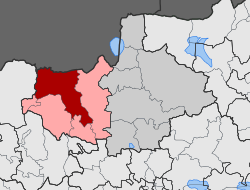Axioupoli
|
Axioupoli Αξιούπολη |
|
|---|---|
| Coordinates: 40°59′N 22°32′E / 40.983°N 22.533°ECoordinates: 40°59′N 22°32′E / 40.983°N 22.533°E | |
| Country | Greece |
| Administrative region | Central Macedonia |
| Regional unit | Kilkis |
| Municipality | Paionia |
| • Municipal unit | 284.4 km2 (109.8 sq mi) |
| Population (2011) | |
| • Municipal unit | 5,619 |
| • Municipal unit density | 20/km2 (51/sq mi) |
| Community | |
| • Population | 3,049 (2011) |
| Time zone | EET (UTC+2) |
| • Summer (DST) | EEST (UTC+3) |
| Vehicle registration | ΚΙ |
Axioupoli (Greek: Αξιούπολη), known until 1927 as Boymitsa (Боймица, Μποέμιτσα), is a small town and a former municipality in the former Paionia Province of Kilkis regional unit, Greek Macedonia. Since the 2011 local government reform it is part of the municipality Paionia, of which it is a municipal unit. The municipal unit has an area of 284.406 km2. In 2011 the town had a population of 2,897, and the municipal unit 5,619.
Its ancient name was Atalanti and it was established in prehistoric times. Atalanti was conquered by Bottieans who came into the area in the 12th century BC. In the 5th century BC Atalanti was annexed in the Macedonian kingdom and by that time it followed the Greek history. The Bulgarian and Macedonian name is Boymitsa/Bojmica (Cyrillic: Боймица/Бојмица) by which the town was known until the name was changed in 1927. There have been suggestions that its former name was obtained during the era of Byzantine Empire and its transliteration means strong. Slavic tribes, who entered the area in the 7th century AD, named the area Boymitsa, which means 'little Boymia', because the valley of Axios looks like the Valley of Bohemia (although during the Ottoman era the valley of Axios river used to be called Roumlouki, meaning 'Valley of Greeks'). The town was renamed Axioupoli on 1 January 1927, after the river Axios in its vicinity.
Refounded in 1760 by Christian settlers from adjoining areas, they chose it as their new home due to its proximity to the Axios River, near the ruins of ancient town Atalanti. The town form part of the Ottoman Empire until the early 20th century. In the Greek revolution of 1821, inhabitants of Axioupolis and other villages, fought against Ottomans. The family of Papazafiriou Stamatiadi from Idomeni gave the most famous Greek fighters of 1821. The Ottoman troops defeated the rebels in the area, and the revolution continued only in Southern Greece. Construction of Axioupolis' first church, Saint Dimitrios (Greek: Αγίου Δημητρίου), started in 1843 after Christians were given the right to build churches and schools by the Ottomans. Saint Dimitrios was completed in 1859. During the national competitions in the area, a lot of locals resisted in the Internal Macedonian Revolutionary Organization (IMRO), while others participated in the struggle led by IMRO. A committee of IMRO was founded in Boymitsa in 1896. Its leader was the local Bulgarian teacher Filip Dimitrov. From Greek side, from Idomeni, Nikolaos Stoidis', Stoikos Stoidis' and Dellios Kovatsis' teams act. From Gevgelija, Demosthenes Kyrou organizes the Greek defence in all over the area. From Gevgelija also, Christos Dellios' and Simos Malios' teams act. Athanassios Giangkoulas', Ioannis Taskos' and Petros Charissiadis' teams act from Negorci. In the area of municipality of Axioupolis, there are also the teams of Athanassios Kapetanopoulos and Petros Avramidis from Tikveš. The leaders Nikolaos Nikoltsas, Georgios Xanthos and Dellios Petkou Topalis from Mrzenci had an important participation to the Greek defence in the area. Dellios Petkou Topalis killed in 1898 by Bulgarians.
...
Wikipedia


